This post may contain affiliate links which may generate a small commission from clicks that result in a purchase.
If you are growing olive trees, you should also know what may go wrong with them. That way, you will not be left hanging if you see them. It takes a lot of effort from planting your cuttings to the pot or ground and watching them grow. You wouldn’t want to end up clueless when something not right happens.
Like for example, olive tree leaves turning brown can surely alarm you. It’s supposed to be green to call it a healthy olive tree. But what causes olive tree leaves turning brown, and how can you treat them?
The main reasons olive tree leaves turn brown and fall off are overwatering, poor drainage, overfertilizing, or distress. Also, olive leaves change color into brown if affected by olive peacock spots, verticillium wilt, other pests, and diseases.
This may sound unfamiliar to you, so for this reason, keep reading down below my article, where I explained in detail for you to learn more about the causes and ways to cure them.
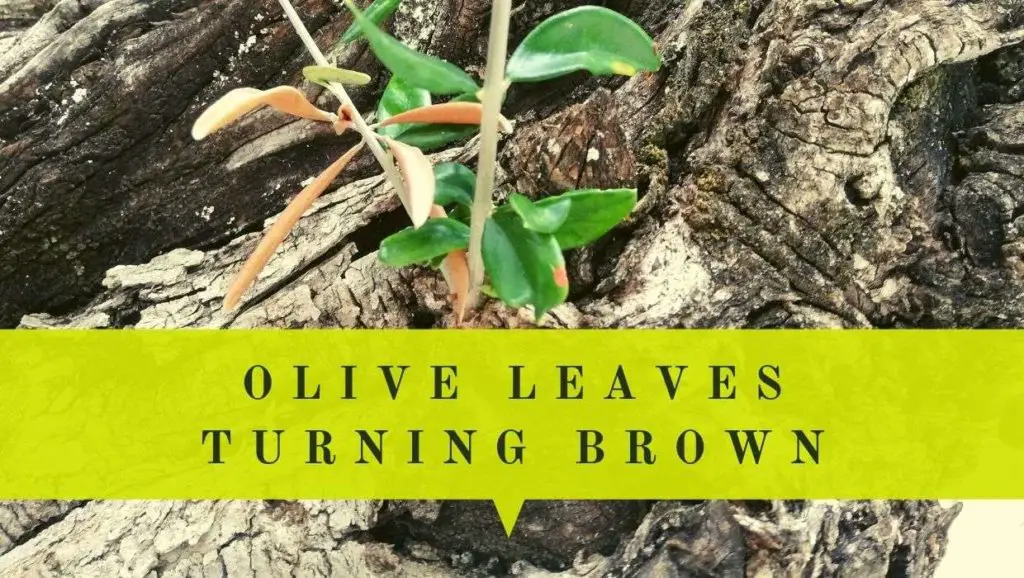
- I. Why My Olive Tree Leaves Turning Brown & How to Treat it?
- 1. Natural Leaf Shedding
- 2. Overfertilizing
- 3. Nutrient Deficiencies
- 4. Watering Issues
- 5. Environmental Changes
- 6. Pests or Insects Attack
- 7. Diseases
- II. Steps to Save Olive Tree Leaves Turning Brown
- 1. Inspect the Root System
- 2. Assess Soil and Drainage
- 3. Examine Roots for Health and Structure
- 4. Check for Fertilizer Residue or Salt Buildup
- 5. Ensure Adequate Sunlight
- 6. Establish Proper Watering Routine
- 7. Monitor for Pests and Diseases
- 8. Address Environmental Stressors
- 9. Proper Care and Maintenance
- 8. Be Patient
- III. Prevention
- IV. Items You May Need to Treat Your Olive Tree
- V. Frequently Asked Questions
- VI. Final Thoughts
I. Why My Olive Tree Leaves Turning Brown & How to Treat it?
Though olive tree leaves problems can differ for indoor potted trees and olive trees exposed in landscapes outdoors, brown tips arise for the same primary reasons: overfertilizing, overwatering, underwatering, or distress. Once your olive leaves tips turn brown, those dead tip cells can’t be revived, but quick corrections can help restore the overall health of your olive tree.
In the worst-case scenario, pest infections or diseases may damage your tree leaves. So here I listed the main reasons that can cause this problem and explained solutions.
| Reason | Cause | Solution |
|---|---|---|
| Natural Leaf Shedding | Seasonal changes, Lifespan of leaves | No action needed, monitor tree for other issues |
| Overfertilization | Excessive fertilizer application | Reduce fertilizer use, leach soil with water, use slow-release or organic fertilizers |
| Nutrient Deficiencies | Iron, Manganese, or Potassium deficiency | Test soil, apply appropriate nutrient supplements, balance soil pH |
| Overwatering | Excess water, poor drainage | Reduce water frequency, improve drainage, monitor soil moisture |
| Underwatering | Insufficient water | Increase water frequency, water deeply, monitor soil moisture |
| Temperature Extremes | Extreme heat or cold | Provide shade/protection, water appropriately, choose well-adapted varieties |
| Wind Damage | Strong winds | Install windbreaks, stake young trees, choose sheltered planting sites |
| Salt/Chemical Exposure | Salt accumulation, chemical exposure | Flush soil with water, avoid chemical spills, use salt-tolerant varieties |
| Transplanting Distress | Transplant shock, moving shock | Water deeply, prune damaged roots, provide temporary shade, avoid over-fertilization |
| Insufficient Light | Lack of sunlight | Prune surrounding vegetation, relocate tree if possible |
| Inconsistency | Inconsistent care | Establish a routine care schedule, monitor tree’s needs regularly |
| Pest Infestations | Olive fruit fly, Scale insects, Aphids | Monitor for pests, apply appropriate treatments, use natural predators when possible |
| Fungal Infections | Anthracnose, Verticillium Wilt | Remove and dispose of infected plant material, apply fungicides, improve air circulation |
| Bacterial Infections | Olive Knot, Bacterial Leaf Scorch | Remove and dispose of infected plant material, apply bactericides, maintain tree health |
1. Natural Leaf Shedding
Before we dive into potential problems of olive tree leaves, remember that not all leaf browning is a cause for concern. In some cases, it’s just Mother Nature doing her thing!
Seasonal Changes
As the seasons change, it’s perfectly natural for olive trees to shed some of their leaves. You might notice some browning and leaf drop, especially during late fall and winter. This is your tree’s way of adapting to the changing environment and conserving energy.
So, if you notice some browning leaves during these times, don’t panic – it’s all part of the cycle of life!
Lifespan of Leaves
Did you know that olive tree leaves have a lifespan? That’s right! On average, an olive tree leaf will live for around two to three years. As they reach the end of their life, it’s normal for these leaves to turn brown and eventually fall off. This is just the tree making room for fresh, new leaves to grow and flourish.
So, if you see a few brown leaves here and there, it’s likely just the circle of life in action.
Solutions
While natural leaf shedding due to seasonal changes or the lifespan of leaves isn’t a cause for concern, you can still take a few simple steps to help your olive tree maintain its health and appearance:
- Regular Pruning: Prune your olive tree once or twice a year to remove dead or damaged branches, promote air circulation, and encourage healthy growth. Pruning also helps maintain a balanced shape and ensures the tree focuses its energy on producing new, healthy leaves and olives.
- Maintain a Clean Environment: Regularly clean up fallen leaves and debris from around the base of your tree. This helps prevent the growth of fungi or pests that could harm your tree.
- Monitor Tree Health: Keep an eye on your tree throughout the year to ensure it’s staying healthy. If you notice an unusual increase in brown leaves or any other signs of distress, it may be time to investigate further and address any potential issues promptly.
2. Overfertilizing
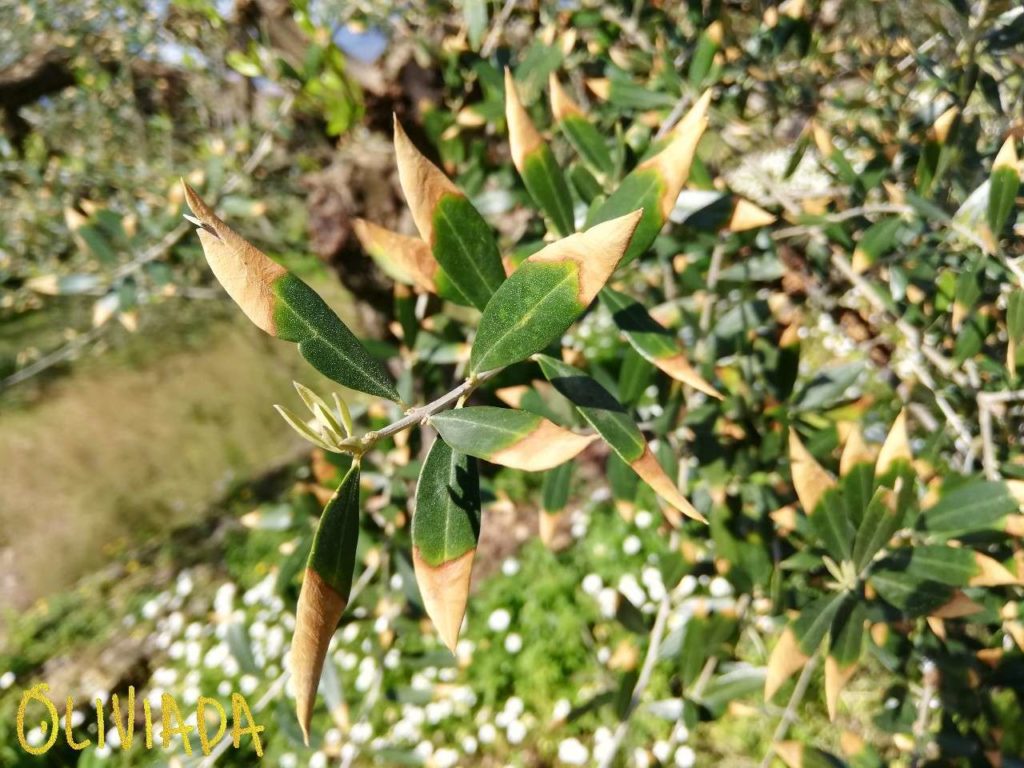
If your olive tree leaves tips are browning, that can mean your tree has been overfertilized or there is a buildup of fertilizer salts in the soil.
Overfertilization occurs when we apply too much fertilizer to our olive trees, thinking that more nutrients will lead to a healthier and more productive tree. However, an excess of nutrients can overwhelm the tree’s roots, leading to what’s known as “fertilizer burn.” This causes the leaves to turn brown and may even lead to leaf drop.
Solutions
To help your tree recover from overfertilization and prevent future issues, follow these expert tips:
- Repot the Tree: In case of heavy overfertilization, stop fertilizing your olive tree immediately and repot it to refresh the soil.
- Less is More: When fertilizing your olive tree, remember that less is often more. Always follow the recommended application rates on the fertilizer packaging, and consider using a slow-release fertilizer to supply nutrients gradually over time.
- Test Your Soil: Before applying any fertilizer, it’s a good idea to test your soil to determine its nutrient levels. This will help you understand exactly what your tree needs and avoid unnecessary overfertilization.
- Proper Watering: Ensure your tree receives adequate water, especially after fertilizing. Water helps the nutrients to dissolve and reach the tree’s roots, preventing fertilizer burn. However, be mindful not to overwater, as this can cause new issues.
- Observe and Adjust: Keep a close eye on your tree’s health and appearance after fertilizing. If you notice any signs of overfertilization, such as browning leaves or slowed growth, take a step back and reevaluate your fertilization plan.
If you have any concerns about which fertilizer suits your olive trees and the fertilization plan, I have an in-depth guide on the best fertilizer for olive trees.
Looking for a Personalized Gift?
Adopt an OLIVE TREE in Greece –
Receive Premium Olive Oil!
3. Nutrient Deficiencies
Another reason your olive tree’s leaves might turn brown is nutrient deficiencies. Just like us, olive trees need a balanced diet of essential nutrients to thrive. When they don’t get enough of these key nutrients, it can lead to browning leaves and other health issues. Let’s explore some of the most common nutrient deficiencies that can affect your olive tree:
Iron Deficiency
Iron impacts chlorophyll’s production, giving leaves their green color and helping them produce energy through photosynthesis. If your olive tree isn’t getting enough iron, its leaves may turn yellow and eventually brown.
To treat iron deficiency, apply an iron chelate or iron sulfate to the soil, following the recommended application rates.
Manganese Deficiency
Manganese is another vital nutrient for olive trees in photosynthesis and plant growth. When there is insufficient manganese, the leaves may develop yellow or brown spots, often appearing between the veins.
You can address manganese deficiency by applying a manganese sulfate solution to the soil or foliage.
Potassium Deficiency
Potassium is essential for overall plant health, helping with water regulation and producing proteins and carbohydrates. A potassium-deficient olive tree may have leaves with brown edges, and the tree’s overall growth may be stunted.
To remedy potassium deficiency, consider applying a potassium-rich fertilizer or adding organic matter, like compost, to the soil.
Solutions
To address the nutrient deficiencies causing your olive tree leaves to turn brown, here are some solutions you can implement:
- Soil Testing: To accurately diagnose and treat nutrient deficiencies, start by testing your soil. This will give you a clear understanding of which nutrients are lacking and help you create a tailored fertilization plan to meet your tree’s needs.
- Balanced Fertilization: Use a balanced, slow-release fertilizer formulated explicitly for olive trees. This will help provide the necessary nutrients in proportions, ensuring your tree has everything it needs to thrive.
- Amend Soil: If your soil test reveals deficiencies, consider amending your soil with nutrient-rich organic matter, like compost or well-aged manure. This can help improve soil structure, water retention, and nutrient availability.
- Foliar Sprays: In cases of severe deficiencies, you can apply nutrient-specific foliar sprays directly to your tree’s leaves. This provides a quick boost of essential nutrients, allowing your tree to begin recovering sooner. Be sure to follow the product instructions carefully to avoid causing additional harm to your tree.
- Monitor and Adjust: Keep a close eye on your tree’s health and appearance after implementing these solutions. It may take some time for your tree to recover fully, so be patient and adjust your care routine as needed. If you notice any new or worsening symptoms, consult a local expert for further advice.
4. Watering Issues
Watering issues are another common cause of browning leaves on olive trees. Let’s take a closer look at how overwatering, underwatering, and poor drainage can impact your tree and what you can do to help.
Overwatering
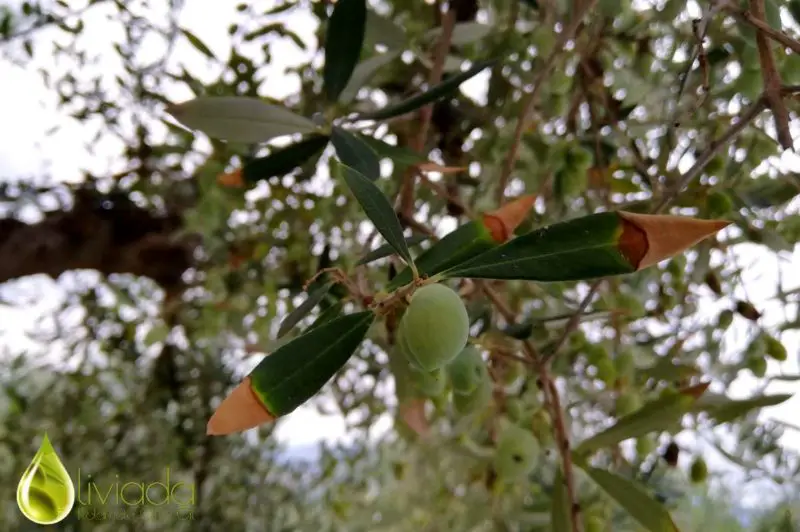
Olive trees are pretty drought-tolerant and can suffer if they receive too much water. To explain overwatering briefly: the roots wick up the water to the olive tree body. The tree cells fill up, one by one, and attempt to pass the liquid on to the next cell.
Such water flow works wonderfully until the moisture reaches the cells located at the end of the line – in the olive leaves. These cells have no place to pass excessive moisture onto, so they continue to fill until they burst, creating crusty brown tips on the edges of the olive leaves.
Chronic overwatering generally causes olive tree root rot and fungal issues that are perfect for supporting a healthy colony of unpleasant fungus gnats and other parasites. Leading leaves to turn yellow, then brown, and eventually fall off.
Read about another symptom of overwatering, the change in the appearance of olive leaves turning yellow.
Water your tree deeply but infrequently to avoid overwatering, allowing the soil to dry out slightly between watering sessions. A good rule of thumb is to water once every 1-2 weeks during the growing season, and less often in cooler months.
Underwatering
In addition, very common to see olive tree leaf tips turn brown because of underwatering when lost water can’t be replaced for some reason.
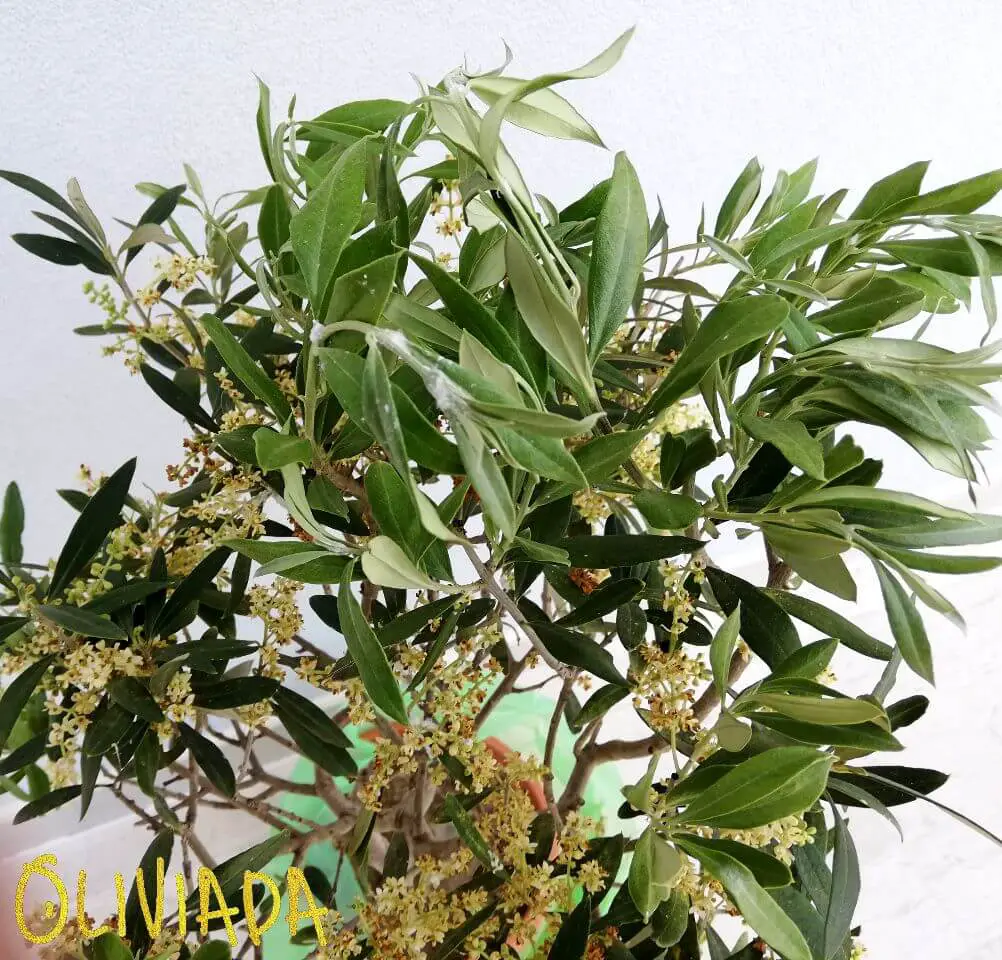
Typically, water flows from olive tree roots through stems and water canals until it finally reaches leaf tips last. But if water resources are limited, other tree parts get served first. As a result, olive leaves tip cells lose out and die from a kind of drought.
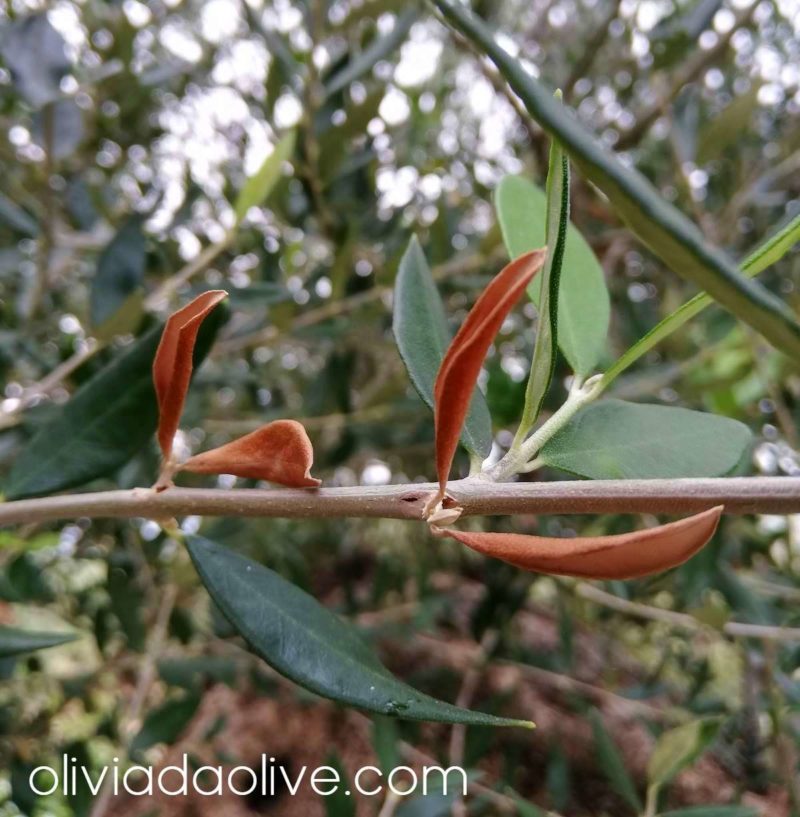
If you’re unsure whether your tree needs water, check the soil a few inches below the surface. If it feels dry, it’s time to water. Remember, deep and infrequent watering is better than frequent, shallow watering.
Poor Drainage
Olive trees need well-draining soil to prevent root rot and other water-related issues. If you find that water pools around the base of your tree after watering or rainfall, it’s a sign that the soil isn’t draining properly.
To improve drainage, consider amending the soil with organic matter, like compost or perlite, or creating a raised planting bed to help excess water escape more easily.
Solutions
Here’s how you can address the watering issues that may be causing your olive tree leaves to turn brown:
- Establish a Watering Routine: Create a consistent watering schedule for your olive tree, adjusting it according to the season, weather, and tree age. As a general guideline, water deeply and infrequently, allowing the soil to partially dry out between watering sessions. This will help your tree develop a robust root system and prevent issues related to overwatering or underwatering.
- Use the Right Soil Mix: Ensure your olive tree is planted in well-draining soil. You can create a suitable soil mix by combining garden soil with organic matter, such as compost, and an inorganic component like perlite or sand. This will help improve drainage and aeration while providing necessary nutrients for your tree.
- Monitor Soil Moisture: Regularly check the soil moisture a few inches below the surface to determine when your tree needs water. Use your fingers or invest in a soil moisture meter to simplify this task. This will help you avoid both overwatering and underwatering your olive tree.
- Improve Drainage: If your olive tree is planted in a location with poor drainage, consider creating a raised bed or planting it on a slope to promote better water runoff. Alternatively, transplant your tree to a well-draining pot or container.
- Mulching: Applying a layer of mulch around the base of your tree can help regulate soil moisture and temperature, reducing the risk of overwatering or underwatering. Opt for organic mulches like wood chips, bark, or straw, and ensure you leave some space between the mulch and the tree trunk to prevent pest infestations and rot.
5. Environmental Changes
If overfertilization, overwatering, or underwatering has not satisfactorily explained your problem, then there may be another explanation. Many circumstances in an olive tree’s environment can lead to browning leaves.
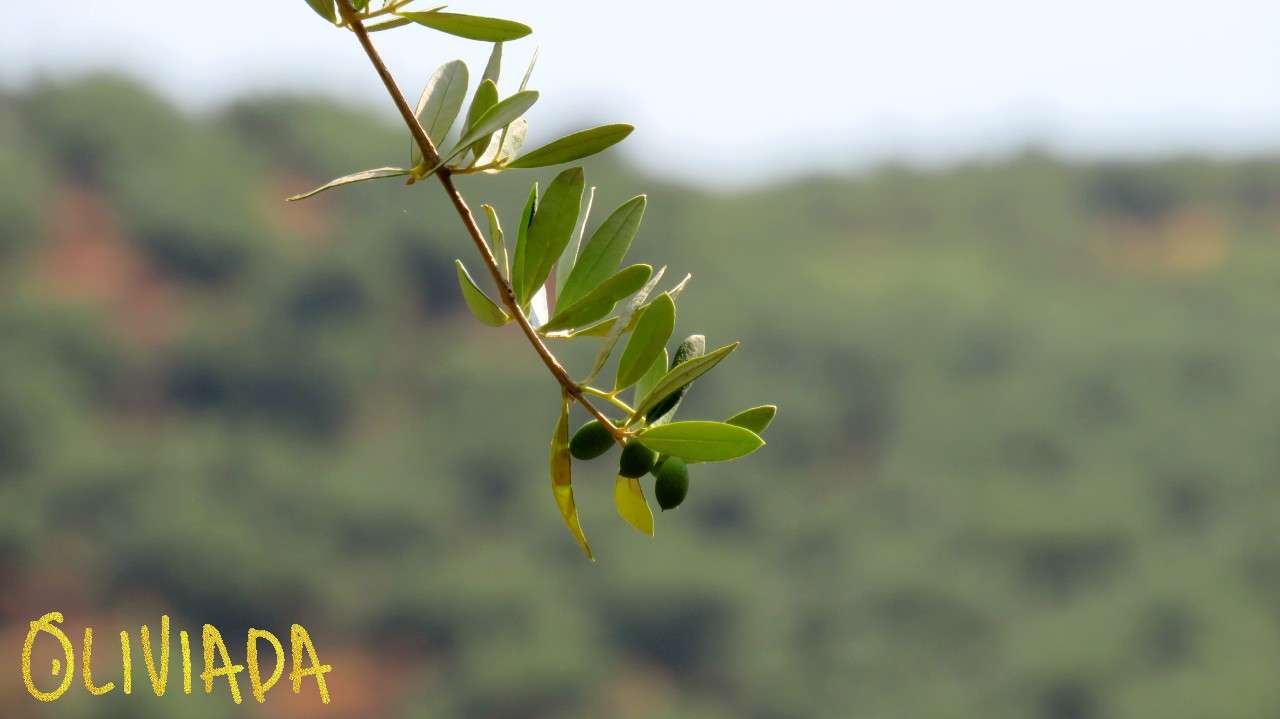
Temperature Extremes
Olive trees are known for their love of sunshine and warm climates, but even these hardy plants can be sensitive to temperature extremes. Both scorching heat and freezing cold can stress your tree, causing leaves to turn brown and, in some cases, drop off altogether.
Most commonly, cold is a factor in creating a moisture-rich environment for an olive tree, but hot and humid settings can be equally damaging.
During periods of extreme heat, ensure your tree has enough water. Keep an eye on the soil moisture and adjust your watering routine as needed to prevent the tree from becoming too dry. Additionally, you can provide some relief from the heat by using shade cloth or a temporary canopy to protect your tree during the hottest parts of the day.
On the other hand, if you’re faced with freezing temperatures, protect your olive tree from frost damage. To keep them warm, you can wrap the trunk and branches with frost blankets, burlap, or even Christmas lights. Keep the tree well-watered (but not overwatered) in the weeks leading up to an expected frost, as hydrated trees are better equipped to handle cold temperatures.
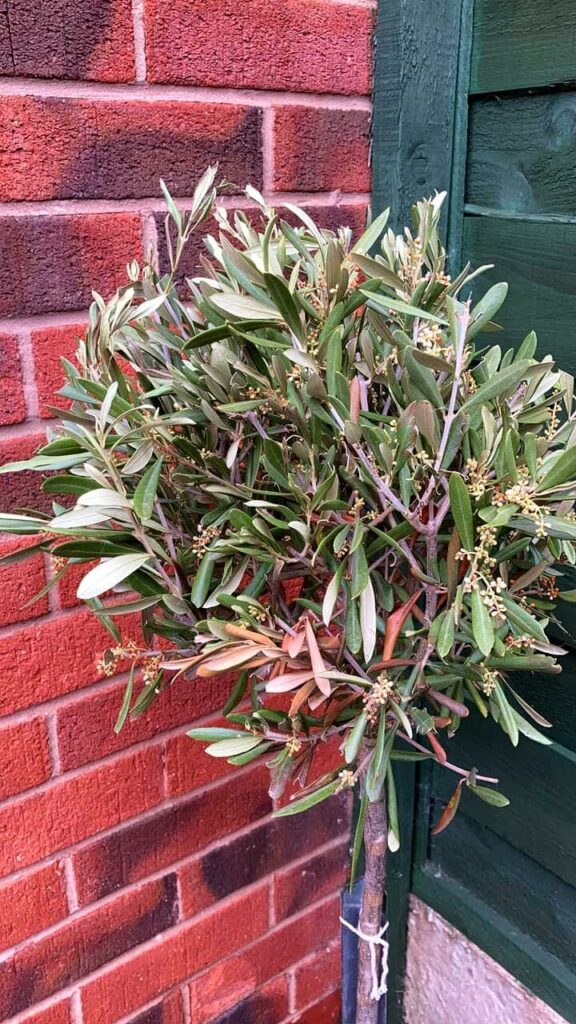
Wind Damage
Wind damage can cause your tree’s leaves to become tattered, dry, and eventually turn brown. Strong gusts can break branches or uproot your tree in extreme cases.
Consider planting a windbreak or installing a protective barrier to shield your olive tree from strong winds. Windbreaks can be made from other trees or shrubs better suited to handle the wind, or you can use a fence or trellis. These barriers will help protect your olive tree from the brunt of the wind, keeping its leaves green and healthy.
If you live in an area prone to strong winds or storms, keep an eye on your olive tree’s health and check for any signs of damage after windy days. This will allow you to take prompt action, such as providing additional support to the tree, pruning damaged branches, or treating any wounds to prevent infection.
Salt or Chemical Exposure
Sometimes, it’s not just the weather that can affect your olive tree’s well-being. Salt from ocean spray or chemicals from nearby roadways and construction sites can also cause your tree’s leaves to turn brown and suffer other damage.
To protect your tree from salt or chemical exposure, give its leaves a gentle rinse with fresh water as soon as you notice any signs of damage. This will help wash away the harmful substances and prevent further harm. Make this a regular part of your tree care routine, especially if you live in a coastal area or near a busy road.
If you’re planting a new olive tree and are concerned about salt or chemical exposure, consider selecting a planting site that’s further away from the source of these substances. You can also plant a barrier of taller trees or shrubs, or even install a fence or trellis to shield your olive tree from harmful elements.
Transplanting Distress
Transplanting your olive tree, whether it’s moving from a pot to the ground or relocating it to a new spot in your garden, can be a little nerve-wracking for both you and your tree. It’s common for olive trees to experience some distress during the transplanting process, which can manifest as browning leaves or even leaf drop.
Root damage while transplanting prevents tree roots from doing their job and feeding all the parts of the olive tree. As a result, the olive leaf tip becomes brown and dies.
To help ease your tree’s transplanting distress, be gentle with its roots during the process. Avoid damaging the root ball and moisten the roots while preparing the new planting site. Once your tree is in its new location, ensure it has the proper soil conditions, well-draining soil, and the right nutrients to support its growth.
Water your newly transplanted tree consistently, but be careful not to overwater. Keep the right balance to help your tree establish a healthy root system in its new environment. Monitor the soil’s moisture level and adjust your watering routine as needed.
Patience is key during this time. It may take a few weeks, or even months, for your tree to fully adapt to its new surroundings and recover from the transplanting process. Continue to provide it with the proper care, including watering, fertilizing, and pruning as needed.
Insufficient Light
Ideally, olive trees require 6 to 8 hours of sunshine per day. If the olive tree has less light than it needs to thrive, it will slow down its functions. The tree will not use water as fast as it would if it were in the proper light conditions, leading to excess moisture and leaves turning brown or even falling off.
First, take a look at the surrounding environment. Are there any large trees, buildings, or other structures that may be casting shade on your olive tree? If so, consider pruning the branches of nearby trees or even relocating your olive tree to a sunnier spot in your garden. For container-grown trees, simply move the pot to a location with more sunlight.
Keep in mind that olive trees need at least six hours of direct sunlight per day to thrive. If your tree still isn’t getting enough light, you might need to get creative. Consider using a grow light for indoor trees to supplement the natural light it receives. These artificial light sources can give your tree the boost it needs to grow strong and healthy.
Inconsistency
If you tend to neglect your olive tree to the point of wilting and then overcorrect by giving it a huge drink, an olive tree will typically force too much water through its cells, creating a similar overabundance of moisture. Inconsistent care, such as irregular pruning, can stress your olive tree and cause leaf browning.
With a bit of dedication and commitment, we can get back on track and give our trees the consistent care they need to flourish.
Start by creating a care schedule for your olive tree. Mark your calendar with watering, fertilizing, and pruning reminders to ensure your tree gets the attention it needs. Remember that consistency is key, and maintaining a regular routine will help your tree adapt and thrive.
Pay close attention to your tree’s water needs. Inconsistent watering can lead to stress and brown leaves. Develop a watering schedule based on the tree’s requirements and the local climate. Check the soil moisture regularly and adjust your watering routine as needed.
In addition, stick to a regular fertilizing schedule using a balanced, slow-release fertilizer designed for olive trees. Consistent, proper fertilization will provide your tree with the nutrients it needs to grow strong and healthy.
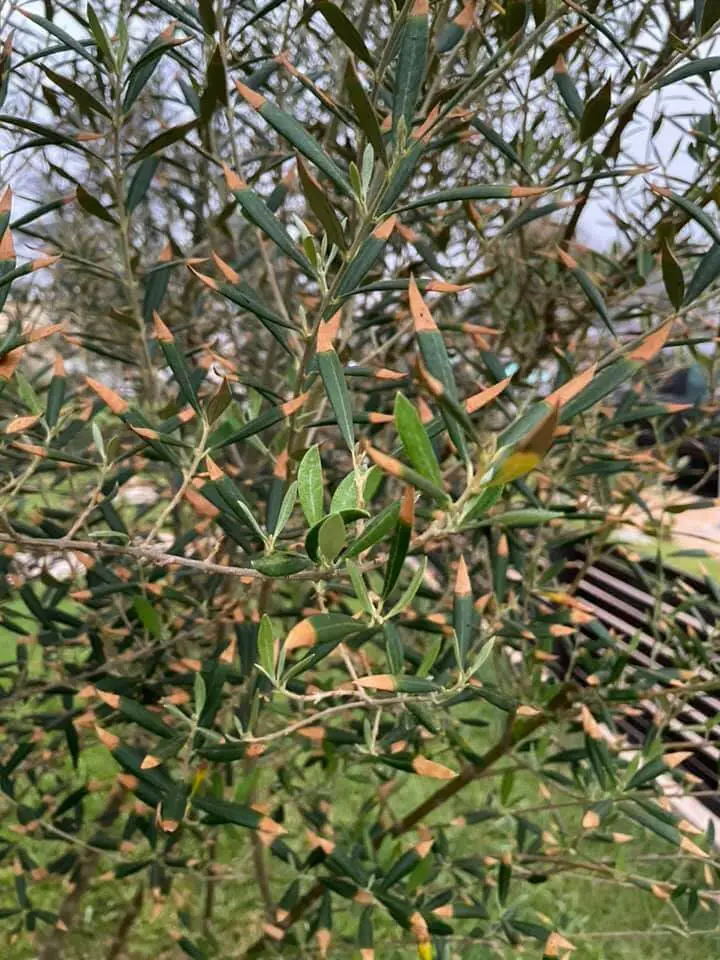
6. Pests or Insects Attack
Another reason your olive tree’s health is under suspicion if it has unwelcome guests: pests or insects.
Carefully observe the tree, and check the foliage and stems for signs of pests such as scale insects. Not sure what scales look like and how to get rid of scale, check out my informative article about scale insects here.
There are many more pests that can harm your olive tree. So the most important first is to identify the pest and treat it accordingly.
Last update on 2024-04-12 / Affiliate links / Images from Amazon Product Advertising API
Olive Fruit Fly
The olive fruit fly (Bactrocera oleae) is a pest that mainly targets the fruits of the olive tree. It lays its eggs in the fruit, and the larvae feed on the fruit pulp, causing damage and reducing the quality of the fruit. While the olive fruit fly doesn’t directly cause the leaves to turn brown, the damage to the fruits can weaken the overall health of the tree, making it more susceptible to other issues that may lead to browning leaves.
Monitor your tree and look for small, discolored spots on the olives, indicating that eggs have been laid. If you spot any signs of an infestation, it’s time to take action.
Solutions
One effective method for controlling olive fruit fly populations is using traps. You can find specially designed traps at your local garden center or make your own using a mixture of yeast, sugar, and water. Hang the traps in your tree to attract and capture the adult flies, which will help reduce their numbers and prevent further damage to your olives.
Another important step in managing olive fruit fly infestations is proper sanitation. Keep the area around your tree clean and free of fallen fruit, which can harbor larvae and attract more flies. Regularly inspect your tree for damaged olives and remove them promptly to prevent the spread of the infestation.
Scale Insects
Scale insects are small sap-sucking pests that can infest a variety of plants, including olive trees. They feed on the plant’s sap, weakening the tree and making it more susceptible to other problems, such as sooty mold. The sooty mold grows on the honeydew excreted by the scale insects, potentially blocking sunlight and reducing photosynthesis. Although scale insects don’t directly cause olive tree leaves to turn brown, the stress they cause to the tree and the secondary problems they may introduce can contribute to browning leaves.
Inspect your tree and search for tiny, shield-shaped bugs on the leaves, branches, fruit, and any sticky residue they leave behind. If you find scale insects on your tree, it’s time to roll up your sleeves and take action.
Solutions
One effective way to combat scale insects is by physically removing them from your tree. Use a soft brush or cloth dipped in soapy water to gently wipe the insects from the leaves and branches. Be sure to reach all the affected areas, as scale insects can be quite persistent.
For more severe infestations, consider using a horticultural oil or insecticidal soap. These products are designed to smother and kill insects without causing harm to your tree.
If you need more information on how to get rid of scale, check out my article about scale insects.
Aphids
Aphids are small, soft-bodied insects that suck sap from leaves and stems, causing curling and yellowing of leaves. As they feed, they excrete a sticky substance called honeydew, which promotes the growth of sooty mold. This mold can interfere with photosynthesis, leading to browning of the leaves. Additionally, the damage caused by aphids’ feeding may result in browning and leaf drop.
To keep aphids at bay, regularly inspect your olive tree for signs of their presence. Look for clusters of small, pear-shaped insects on the leaves and stems and any sticky residue or distorted growth they may cause. If you find aphids on your tree, it’s time to take action.
Solutions
One simple and effective way to combat aphids is by spraying your tree with a strong blast of water from a garden hose. This will dislodge the insects and help to wash away any honeydew or residue they leave behind. Be sure to thoroughly spray all affected areas of your tree to ensure you’ve removed as many aphids as possible.
For more persistent infestations, you can turn to natural predators, such as ladybugs or lacewings, which love to feast on aphids. You can purchase these beneficial insects from a local garden center or online and release them onto your tree to help control the aphid population.
Consider using insecticidal soap or horticultural oil to treat your tree in severe cases. These products are designed to kill aphids without causing harm to your olive tree.
| Common Pests | Signs and Symptoms | Treatment Options | Preventative Measures |
|---|---|---|---|
| Olive Fruit Fly | Tiny punctures on fruits, premature fruit drops, maggots in fruit, browning leaves | Bait traps, insecticides, natural predators (parasitic wasps) | Regular monitoring, sanitation (remove infested fruit), timely harvesting |
| Scale Insects | Yellowing and browning of leaves; small, round, brownish or black insects on branches and leaves | Horticultural oil, insecticidal soap, or systemic insecticides | Monitor trees regularly, avoid over-fertilizing, encourage natural predators. |
| Aphids | Curling and yellowing or browning of leaves, sooty mold, leaf drop; small, soft-bodied insects on leaves and stems. | Insecticidal soap, horticultural oil, neem oil, natural predators (ladybugs) | Monitor tree regularly, avoid over-fertilizing, encourage natural predators |
7. Diseases
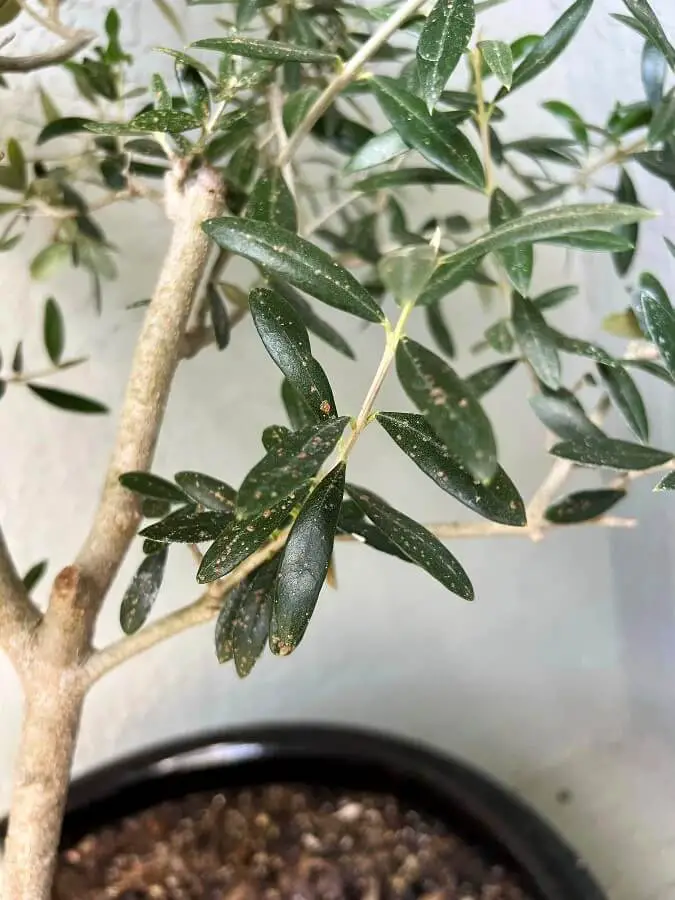
Various olive tree diseases may affect leaves and cause discoloration. It can start from the leaf and spread on branches and the rest of the tree.
Peacock Spots
If an olive tree is affected by the fungal disease peacock spot infection, also known as olive leaf spot, it will have circular yellow and brown spots on the leaves. That’s an alarming color of olive tree leaves, which means that it needs to be cured as soon as possible. It can cause the leaves to fall, and your tree can no longer photosynthesize.
Peacock spot disease occurs mostly in California’s olive-growing regions.
Solutions
The good news is, it’s treatable, so no need to worry about it too much. First, start by pruning affected branches to increase airflow and sunlight exposure, which helps to keep the fungus at bay. Remove and dispose of any fallen leaves, as they can harbor spores.
Finally, you can treat the olive peacock spots by spraying them with fungicide or copper mixture. To prevent the peacock spots will not be affecting your olive trees, do this once in November and in February. It will ensure that your plants will stay healthy and produce fresh olive fruits that you can enjoy for a long time.
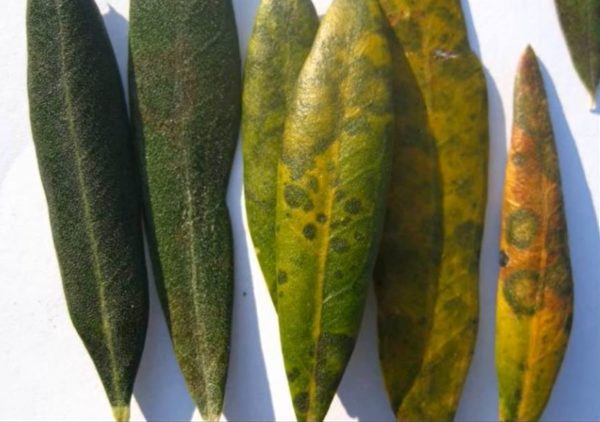
Verticillium Wilt
Another cause of olive tree leaves turning brown is they may be suffering from verticillium wilt. It happens if there is no proper drainage system from the soil. It can also occur if the olive trees are overwatered. The roots of the plant will have an oxygen shortage, and it can cause to get infected by the verticillium wilt.
Verticillium wilt is a fungal infection that is present in the soil. It can affect the plants from the roots and travel through the branches and leaves. This soil-borne fungus can cause brown spots on leaves, yellowing, wilting, and eventual decline of the tree. Flowers and fruits can also be affected by this fungus.
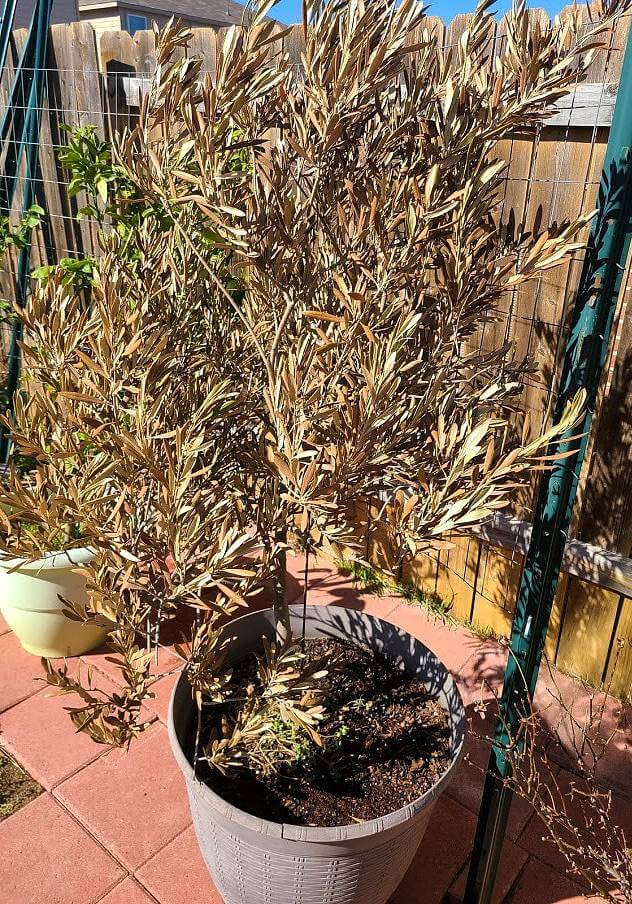
Solutions
Not just because this fungal infection lives in the soil, you cannot do anything about it. You can get rid of the verticillium wilt by soil solarization. Heat the ground six inches or more with enough heat to kill the fungus. Solarization can help eliminate that disease that can be transferred to the olive tree.
You can prepare the soil by digging and wetting it to do this. After that, you can cover it with clear plastic to trap the heat inside. Leave it for three to five weeks so the sun can heat the soil thoroughly and kill the fungus that can affect the plants negatively. Once ready, you can replant your olive trees to the pots or ground.
Prevention
Prevention is the best way to deal with verticillium wilt. However, it’s not as easy as it sounds since this fungal infection lives in the soil itself. The best thing to do is to make your olive tree to be strong enough to avoid getting this disease. It will help to be more resistant to this fungus.
Watering your olive trees regularly and being able to recognize overwatering symptoms can help a lot. Make sure that there’s a drainage system to get rid of the excess water. If possible, provide some shade to them during the afternoon. Pruning unhealthy branches can also be a good idea. Use a fertilizer that has low nitrogen and high phosphorus fertilizer.
Anthracnose
Anthracnose, caused by the fungus Colletotrichum spp., affects olive trees by causing leaf spots, defoliation, and fruit rot. The fungus infects leaves, causing dark brown or black spots to appear. As the infection progresses, the affected areas may merge, leading to extensive browning and leaf drop.
To treat anthracnose, start by removing and disposing of infected leaves, fruit, and twigs to prevent the spread of the fungus. Prune your tree to improve airflow and sunlight penetration, which can help keep fungal growth at bay. Apply a fungicide approved for use on olive trees, following the label instructions for proper application rates and timing.
Olive Knot
Olive Knot, caused by the bacterium Pseudomonas savastanoi, leads to knot-like growths on branches, leaves, and twigs. These knots can restrict water and nutrient flow to the leaves, causing them to turn brown and eventually drop.
To treat olive knot, begin by pruning and disposing of infected branches. Make sure to disinfect your pruning tools between cuts to avoid spreading the bacteria. After pruning, apply a copper-based bactericide to your tree, following the label instructions to protect it from further infection.
Bacterial Leaf Scorch
Bacterial Leaf Scorch, caused by the bacterium Xylella fastidiosa, is a disease that affects a variety of plants, including olive trees. This bacterium colonizes the tree’s xylem, the water-conducting tissues, leading to a disruption in water and nutrient flow to the leaves. As a result, the leaves’ edges turn brown and crispy, followed by leaf drop. This browning typically appears in a scorched pattern, hence the name “Leaf Scorch.”
To manage bacterial leaf scorch, start by removing any affected branches and disposing of them properly. Disinfect your pruning tools between cuts to avoid spreading the bacteria. Maintain good tree health through proper fertilization, watering, and pruning to help your tree resist infection. In some cases, injecting your tree with an antibiotic might be necessary, but consult with a local expert or arborist for guidance on this treatment.
| Diseases | Signs and Symptoms | Treatment Options | Preventative Measures |
|---|---|---|---|
| Peacock Spot | Circular, dark spots on leaves with yellow or brown halos; leaf drop | Fungicides (copper-based), pruning affected branches | Regular pruning, proper spacing, and sanitation; balanced fertilization |
| Verticillium Wilt | Yellowing, browning, and wilting of leaves; branch dieback, vascular discoloration in wood | Remove and destroy infected plant material, solarization of soil, fungicides | Plant resistant varieties, rotate crops, proper watering and fertilization |
| Anthracnose | Brown spots on leaves and fruits, leaf drop, fruit rot | Fungicides, pruning affected branches | Regular pruning, proper spacing, sanitation, avoid overhead watering |
| Olive Knot | Knot-like growths on branches, leaves, and twigs; branch dieback | Pruning affected branches, copper-based fungicides | Sanitation (destroy pruned material), avoid pruning during wet weather, proper tree care |
| Leaf Scorch | Browning and scorching of leaf margins, branch dieback | No effective treatment available; remove and destroy severely infected trees | Regular monitoring, proper tree care, use resistant varieties, avoid spreading bacteria during pruning |
Searching for Premium Olive Oil?
Get OLIVIADA Olive Oil from Kalamata, GREECE!
II. Steps to Save Olive Tree Leaves Turning Brown
If you’re struggling to identify why your olive tree leaves are turning brown and how to address the issue, follow these detailed, step-by-step guidelines.
1. Inspect the Root System
To begin diagnosing the problem, closely examine the roots of your olive tree. This process is easier for potted olive trees, but it can also be done for in-ground trees by digging a small hole near the tree’s base. Carefully observe the roots for signs of damage, rot, or stress, as these issues may be causing the browning of leaves.
2. Assess Soil and Drainage
Olive tree roots require proper aeration and nutrients to thrive, so it’s crucial to ensure they aren’t growing in waterlogged soil. Examine the moisture levels in the soil and adjust your watering routine accordingly. If necessary, consider amending the soil to improve drainage and water retention. This may involve adding organic matter or adjusting the soil’s composition to promote better water movement and air circulation.
3. Examine Roots for Health and Structure
Healthy olive tree roots should be white, firm, and have a fresh, earthy smell. In contrast, unhealthy roots may be gray or brown, soft, and emit a foul odor. Remove any dead or rotting roots and provide the tree with proper care, including adequate watering and fertilization, to encourage the growth of new, healthy roots. If the roots appear wrapped around themselves, address the “root bound” issue by repotting the tree in a larger container or gently loosening the roots before planting in the ground.
4. Check for Fertilizer Residue or Salt Buildup
Excess fertilizer or salt buildup can lead to leaf browning and dropping, a condition known as fertilizer burn. To resolve this issue, flush the soil with water to remove the excess salts and restore balance. To prevent future problems, avoid over-fertilizing your tree and protect it from exposure to road salts or heavy pet use.
5. Ensure Adequate Sunlight
Olive trees need at least six hours of direct sunlight daily to thrive. Ensure your tree is positioned in a south-facing spot with plenty of light. If natural sunlight is insufficient, especially in winter, use a full spectrum grow lamp for young trees. Keep in mind that even trees grown under artificial lights will still benefit from exposure to direct sun.
6. Establish Proper Watering Routine
Regularly test the soil’s moisture levels before watering to maintain healthy olive tree growth. Insert your index finger into the soil; it’s time to water if it feels dry. Water your olive tree deeply and infrequently, allowing the soil to dry out between waterings.
For potted trees, consider using a saucer filled with pebbles at the tree’s base to help balance humidity levels.
| Parameter | Ideal Conditions for Olive Trees |
|---|---|
| Watering Frequency | Spring: every 10-14 days; Summer: every 7-10 days; Fall: every 14-21 days; Winter: every 21-30 days |
| Watering Amount | Small/Young Trees: 3-5 gallons (11-19 liters) per tree; Medium Trees: 5-10 gallons (20-40 liters) per tree; Large/Older Trees: 10-15 gallons (40-60 liters) per tree |
| Soil pH | Slightly acidic to neutral (6.0 – 8.0) |
| Drainage | Well-draining soil, avoid waterlogged conditions |
| Organic Matter Content | 3-5% organic matter, amend with compost if needed |
In this table, categories are approximate, and trees’ specific size and age can vary depending on the variety, growing conditions, and maintenance practices:
- Small/Young Trees: These are newly planted trees, saplings, or trees up to 3 years old. They generally have a height of up to 6-8 feet (1.8-2.4 meters).
- Medium Trees: These are 4 to 10 years old, with a height ranging from 8-15 feet (2.4-4.6 meters).
- Large/Older Trees: These trees are typically over 10 years old and can reach heights of 15 feet (4.6 meters) or more.
7. Monitor for Pests and Diseases
Keep an eye out for any signs of pest infestations or diseases, which can also cause olive tree leaves to turn brown. Common pests like scale insects, aphids, and olive fruit flies can damage leaves, while fungal, bacterial, or viral infections may also lead to leaf discoloration. If you notice any signs of pests or diseases, apply appropriate treatments or seek professional assistance.
8. Address Environmental Stressors
If your tree is suffering from temperature extremes, wind damage, or other environmental factors, do your best to provide protection. This might include using windbreaks, moving the tree to a more suitable location, or adjusting its exposure to sunlight.
9. Proper Care and Maintenance
Ensure your olive tree receives the proper care it needs. This includes regular pruning, maintaining the right soil composition, and monitoring for any signs of distress. A well-cared-for tree is better equipped to withstand and recover from stressors.
For more information about proper care and maintenance, read in my article: care for olive trees in pots
8. Be Patient
Remember that recovery takes time. Once you’ve addressed the underlying issues, give your tree some time to bounce back. Be patient, and continue to provide the best care possible.
III. Prevention
I’ve talked about the various reasons that can cause our precious olive tree leaves to turn brown. But don’t worry – I’m here to share my know-how and experience to help you prevent these issues and keep your trees healthy and strong.
1. Proper Care
Watering
Too much or too little water can lead to brown leaves and other issues when watering our olive trees. To keep your trees happy, water them deeply and consistently, allowing the soil to dry out slightly between waterings. Adjust your watering schedule based on the weather and your tree’s needs.
Relevant articles: water requirements for olive trees in pots
Soil Quality and Amendments
Ensure they’re planted in well-draining soil and maintain a pH between 6.0 and 8.0. Regularly test your soil to monitor nutrient levels and make amendments as needed. Incorporating organic matter, such as compost, can improve soil structure and provide essential nutrients for healthy growth.
Relevant articles: best soil for olive trees
Pruning and Maintenance
Regular pruning helps promote airflow, reduces the risk of pests and diseases, and encourages fruit production. Remove dead, diseased, or damaged branches, and thin out dense growth to allow sunlight to reach the inner leaves. And don’t forget to clean your tools between uses to prevent the spread of diseases.
Relevant articles: How to prune olive trees in pots
2. Nutrient Management
Soil Testing
The first step to providing our trees with the proper nutrients is understanding what’s in our soil. By conducting regular soil tests, we can monitor nutrient levels and pH balance, ensuring our trees receive the necessary nourishment. These tests will help us make informed decisions about amendments and fertilizers, keeping our trees strong and vibrant.
Fertilization
Fertilizing maintains olive trees’ health and prevents leaf browning. Apply a balanced, slow-release fertilizer in early spring and again in fall to support steady growth and fruit production. But remember, moderation is key – over-fertilization can lead to brown leaves and other issues. Always follow the label instructions and adjust the application rate based on your soil test results.
Relevant articles: best fertilizer for olive trees
Organic Alternatives
If you’re looking for a more eco-friendly approach to nutrient management, consider organic alternatives. Compost, aged manure, and worm castings can work wonders for your olive trees, providing essential nutrients and improving soil structure. Mulching with organic materials, like wood chips or straw, can also help conserve moisture and suppress weeds, creating a healthier environment for your trees to thrive.
Relevant articles: organic fertilizers for olive trees
3. Pest Control
I’ve talked about proper care and nutrient management, but what about pesky pests that can turn our tree leaves brown? I’m here to share my expertise on keeping these unwelcome visitors at bay and ensuring our trees stay healthy.
Identification and Monitoring
Most importantly, identify the pests affecting your olive trees and regularly monitor their presence. Keep an eye out for signs of infestation, such as chewed leaves, discolored foliage, or the presence of insects themselves. The sooner we can spot a problem, the faster we can address it and minimize potential damage.
Chemical Treatments
When it comes to controlling pests, sometimes a chemical treatment may be necessary. Always opt for the least toxic option that targets the specific pest you’re dealing with, and apply treatments at the right time to maximize their effectiveness while minimizing harm to beneficial insects.
Biological Controls
Biological controls, like introducing beneficial insects such as ladybugs, lacewings, or parasitic wasps, can help keep pest populations in check. Encouraging natural predators, like birds, by providing nesting sites and feeders can also help protect our trees. Plus, it’s always a good idea to maintain a diverse garden, as this can attract various beneficial insects and create a healthier, more balanced ecosystem.
4. Disease Management
Early Detection
When it comes to diseases, early detection is key! Regularly inspect your olive trees for signs of infection, such as discolored or wilted leaves, cankers, or oozing sap. The sooner we spot a problem, the more effective our treatment efforts will be. Always keep a close eye on your trees, and remember – a vigilant gardener is a successful gardener!
Treatment Options
Once we’ve identified a disease, it’s time to take action. Treatment options may vary depending on the specific disease affecting your tree. Fungal infections often require fungicides, while bacterial infections may need antibiotic treatments. Always follow the label instructions and consult a local expert or extension service for advice on the best action.
Preventative Measures
By adopting preventative measures, we can help protect our olive trees from disease before it even strikes. Keep your trees healthy with proper care, and don’t forget to prune and remove any dead or diseased wood. Sanitize your pruning tools between uses to prevent the spread of disease, and consider applying a protective fungicide or other treatment during the dormant season as an extra layer of defense.
IV. Items You May Need to Treat Your Olive Tree
You don’t need fancy gardening tools to care for your olive tree all year round. However, you can be sure your olive tree gets all the necessary maintenance regarding watering, fertilizing, soil quality, and pruning.
Last update on 2024-04-12 / Affiliate links / Images from Amazon Product Advertising API
- Moisture Meter Before Watering
- Organic Neem Oil to Control Pests
- Pruning Shears to Cut Diseased Branches
Last update on 2024-04-12 / Affiliate links / Images from Amazon Product Advertising API
V. Frequently Asked Questions
Why are my olive tree leaves turning brown?
Olive tree leaves can turn brown for various reasons, including nutrient deficiencies, watering issues, pests, diseases, or environmental stressors. Identifying the root cause of the problem is crucial to address it effectively.
How can I tell if my olive tree has a nutrient deficiency?
A nutrient deficiency in your olive tree may cause yellowing leaves, slow growth, or browning leaf tips. To confirm a deficiency, perform a soil test to determine the lacking nutrients and amend the soil accordingly.
What pests commonly affect olive trees?
Olive trees can be affected by pests such as the olive fruit fly, scale insects, and aphids. These pests can cause damage to the leaves and fruit, which may lead to browning leaves.
Can watering issues cause my olive tree leaves to turn brown?
Yes, overwatering and underwatering can cause olive tree leaves to turn brown. Provide your tree with the right amount of water, allowing the soil to dry out slightly between waterings and ensuring proper drainage.
How can I protect my olive tree from environmental stressors?
To protect your olive tree from environmental stressors like temperature extremes or wind damage, use windbreaks, adjust its exposure to sunlight, or move the tree to a more suitable location.
What diseases can cause olive tree leaves to turn brown?
Diseases such as fungal or bacterial infections can lead to browning leaves on your olive tree. Monitor your tree for signs of infection and treat accordingly with fungicides or other appropriate treatments.
How can I prevent my olive tree leaves from turning brown in the future?
Preventing browning leaves involves proper care and maintenance, including regular pruning, ensuring the right soil composition, addressing nutrient deficiencies, managing pests and diseases, and protecting from environmental stressors. Maintaining your tree’s overall health can minimize the chances of browning leaves.
VI. Final Thoughts
Let’s take a quick look at what we’ve covered so far. Brown leaves on your beloved olive trees can result from various factors, including nutrient deficiencies, improper watering, pests, diseases, or environmental stressors. Thankfully, with careful observation and the right course of action, you can help your tree regain its vibrant, healthy leaves.
If your olive tree has only a few suspicious leaves, it may be just a natural growth cycle where the leaves turn brown, die, and fall off. In this case, you don’t need to worry at all.
However, if your olive tree leaves turning brown massively and the tree is neglected, it can end up getting worse and you should call a local gardener for inspection and respective treatment.
In short, for the best growing results, you should care for your olive tree regularly and check the leaves of the trees whenever you water them. That way, you will know if they are still healthy if there’s something terrible going on.
Preventing any issues with the olive tree leaves is the best way to ensure that the plant will thrive and produce more olive fruits for many years to come.
Lastly, never hesitate to seek expert advice if you’re unsure of what’s causing your olive tree’s leaves to turn brown or if you need assistance finding the best solution. Experienced horticulturists, arborists, or fellow olive tree enthusiasts are invaluable resources who can provide guidance and support.
Read Next:
- Olive Tree Leaves Turning Yellow
- Olive Tree Leaves Curling
- Olive Tree Leaves Dropping Off
- White Stuff on Olive Leaves
- Revive Olive Tree and Bring Back to Life
- Problems with Olive Trees in Pots & Solutions
Hi, I’m Vangelis Kleftogiannis, the founder of Oliviada and an established olive oil expert from Kalamata, Greece. My expertise isn’t just in producing quality Extra Virgin Olive Oil, but also in the cultivation and care of olive trees themselves. I am deeply committed to sharing my knowledge and know-how, helping others understand the intricacies of olive tree growing and the creation of quality olive oil.
Are You Looking to Buy an Olive Tree?
If you are looking to add more potted trees or other plants to your orchard, or if you like to replace a neglected olive tree, the best places to get them are your local nursery or an online nursery.
One of the most reliable and the world's largest online nurseries is Fast Growing Trees. They deliver fast, neat, and healthy plants backed with a 30-day guarantee.






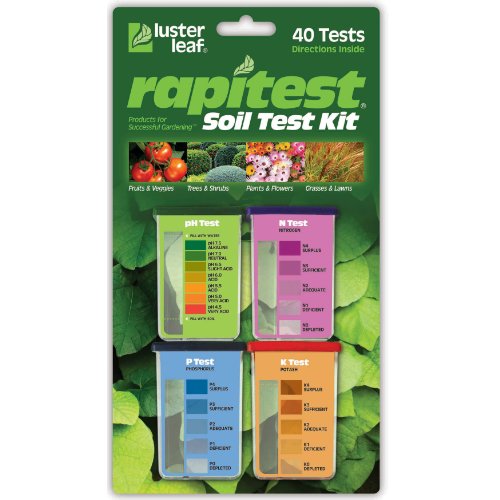


Fungicide or copper mixture.
Where do I get these and how do I apply?
Thanks for your article. Very helpful.
FP
Hi Francis, thank you for your comment. You can find copper fungicide on Amazon (adding an affiliate link to the most recommended product: Bonide Copper Fungicide ). This liquid Copper Fungicide is a protection for plants and helps control powdery mildew, downy mildew, black spot, peach leaf curl, rust, and many other listed diseases. It is easy to use: mix it with water and apply on a tree by using either a hose-end sprayer or tank sprayer. Carefully read and use, according to label directions.
Hi, thanks so much for your article! I have a young olive tree that has its leaves curling downward and upward. I recently added a fertilizer with a 20-20-20 ratio. Since we are in spring, it has a lot of new growth but a few of the new growth is also curling downward. Should I flush out the fertilizer I used to save it? Or will that make it worse bc then the soil will be wet again. I have a moisture monitor and the reading on the guage is right in the middle. So the soil is not too wet and not too dry. I’ve been monitoring it daily and I don’t see any improvement. I would love any advice as to what I should do. Thank you!
Hi Michelle, it is recommended to feed olive trees in spring. However, if a strong consistency fertilizer was applied and you noticed that your tree didn’t like it, then it is better to water again to remove excess fertilizer. It takes time for any tree to recover if the damage to roots is done. I always suggest applying smaller quantities of fertilizer but more often.
My olive tree leaves turn yellow and start Browning from leaf tip.
Hi Shah, brown olive tree leaves may mean too much water, too little water or over fertilization. Try to regulate watering routine and water only when olive tree fully dries out. Also, fertilize it only once per couple months exluding winter season.
Flower buds are turning brown
Hi Marjorie, we would need more information to have a whole picture. Flower buds may turn brown due to too much or too little water, over-fertilization, pests/insects, drastic weather, and other environmental changes.
Thank you for such an informative article. Your analysis helped me to see that the browning of leaves on my two trees are due to over-watering, as we have had a lot of rain this year. Also, our area has clay soils so drainage would be an issue with the rain! Do you have suggestions for improving drainage without disrupting the root system?
Hi Elizabeth, you can check out how to install tile drains. Though it’s often best to involve a landscape professional for this job, cause carefull analysis of a slope, tile depth, and the water outlet is recomended prior to starting.